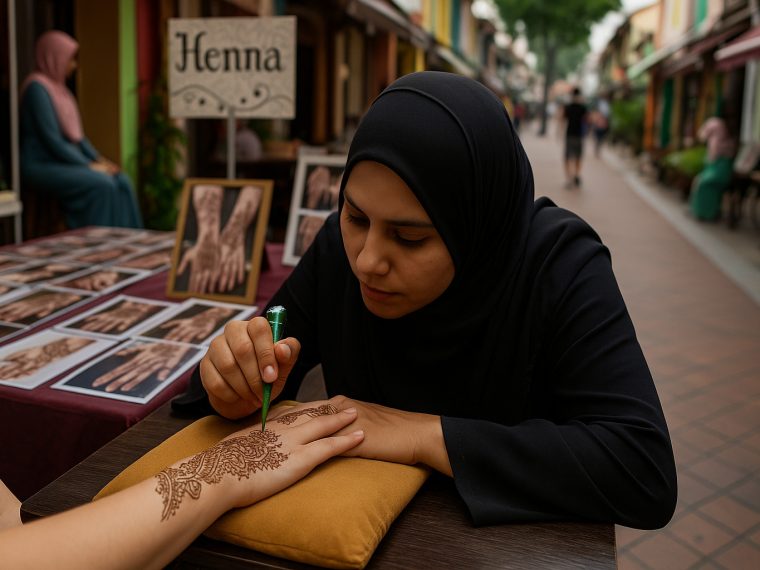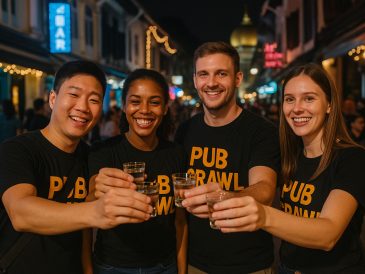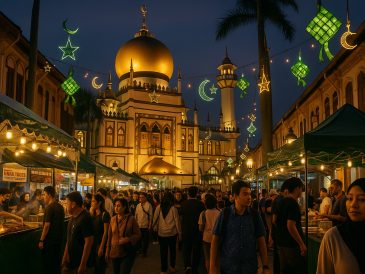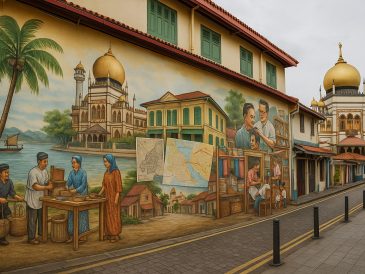Kampong Gelam is the go-to area in Singapore for authentic henna artistry. With its rich heritage and bustling street life, it’s no surprise that this neighborhood offers a deep connection to traditional body art. But with so many stalls and shops, knowing where to find genuine, safe, and beautifully executed henna can save you both time and regret.
Bussorah Street: The Epicenter of Henna Culture
Bussorah Street, a pedestrian-only lane near the Sultan Mosque, forms the nucleus of the henna experience in Kampong Gelam. Artists line the pathway with their setups—some in semi-permanent stalls, others in pop-ups during festive seasons like Hari Raya or the Kampong Gelam Bazaar. The air buzzes with energy, while tourists and locals alike queue for a quick design or sit down for more intricate body art.
What Makes Bussorah Street Stand Out
- Availability: Artists are present most days, with peak activity during weekends and festivals.
- Atmosphere: The surroundings add charm, as traditional architecture meets modern vibrance.
- Variety: From quick-draw tourist pieces to bridal-grade work, options are abundant.
Reputable Henna Artists and Studios
Among the many artists who have passed through Bussorah Street, a few names consistently return in conversations about quality and trust.
1. Pretty Hands
Operating primarily during bazaars and seasonal events, Pretty Hands delivers delicate, dainty designs at reasonable rates. Their patterns lean heavily on traditional Arabian aesthetics, with symmetrical floral motifs and vine-like curls. Look for their booth during the Kampong Gelam Bazaar, especially in the Ramadan period.
Highlights:
- Affordable pricing
- Ideal for quick, small designs
- Popular among tourists
2. SyraSkins
Although their studio is based at Tristar Complex along Geylang Road, SyraSkins often enters conversations around Kampong Gelam’s henna scene. Founded by sisters Mehroon and Syra Gulam, this studio has made a name for its refined detailing and all-natural paste. Their services include bridal packages, group events, and private appointments.
Why Mention Them?
- Known for using only natural ingredients
- Extensive portfolio of both traditional and modern designs
- Offers premium services including bridal henna and party packages
If you’re serious about henna beyond a simple street experience, SyraSkins is a studio worth booking in advance.
Authentic vs. Unsafe Henna: How to Tell the Difference
Not all henna offered in tourist areas is genuine. Some artists use chemical-laced products that can cause skin burns and long-term damage.
Red Flags to Avoid
- Black Henna: True henna never stains the skin black. Black henna contains paraphenylenediamine (PPD), a chemical that can cause allergic reactions, scarring, and blisters.
- Instant Dark Stains: Natural henna takes several hours to develop. Anything promising immediate dark color likely includes chemical dyes.
- Bright Packaged Cones: Mass-produced cones with colorful branding often include preservatives and synthetic additives.
Signs of Authentic Henna
- Color of Paste: Fresh natural henna appears greenish-brown or dark brown.
- Smell: Genuine henna smells earthy or citrusy due to the lemon juice and essential oils used.
- Stain Development: A bright orange stain that darkens over 24 to 48 hours into a reddish-brown is a hallmark of real henna.
- Ingredient Transparency: Skilled artists will list ingredients and won’t hesitate to discuss their paste formulation.
What to Look for in a Henna Artist
Before you sit down and hand over your skin, do a quick check of the artist’s skills and hygiene standards.
Checklist
- Portfolio: A good artist has pictures of past designs and final stains.
- Clean Tools: Watch how the artist handles cones and applies paste.
- Design Consistency: Look for sharp, clean lines without smudging or uneven strokes.
- Client Reviews: If you’re considering a studio or popular artist, a quick online check often helps.
Pricing Expectations
Henna prices in Kampong Gelam are influenced by complexity, coverage area, and artist reputation.
Basic Designs
- Typically range between $8 and $15
- Cover one palm or back of the hand
- Suitable for tourists or casual designs
Intermediate Patterns
- Price ranges from $20 to $50
- Cover the full hand and parts of the wrist
- More detail, with thicker lines and floral elements
Bridal or Elaborate Designs
- Often exceed $150
- Cover both hands and forearms, sometimes legs
- Can include mehndi-style artwork, names, motifs, and personalized patterns
Hourly Rates
- Artists offering group or event services may charge $80 to $125 per hour
- Useful for henna parties, cultural events, or bachelorette gatherings
Always confirm pricing upfront. Some artists display menus or pricing charts, while others provide verbal quotes based on your design selection.
When to Go
Though henna stalls appear throughout the week, certain periods bring a stronger presence of seasoned artists:
- Weekends: Expect more booths and slightly longer waiting times
- Ramadan and Eid: Kampong Gelam becomes a celebration zone, filled with artists and vibrant decorations
- Cultural Festivals: Diwali, Hari Raya Haji, and other cultural holidays bring in more henna activity
Final Notes for a Great Experience
- Bring Cash: Some stalls don’t accept digital payments.
- Wear Loose Sleeves: This prevents smudging during the drying process.
- Stay Still for 15–20 Minutes: The paste needs time to set before you start moving around again.
- Ask About Aftercare: Most artists will advise keeping the paste on for several hours and avoiding water for the first few.
If you’re after real, traditional henna that’s safe, skilled, and visually beautiful, Kampong Gelam—especially Bussorah Street—is your best bet in Singapore. Whether it’s a spontaneous street-side design or a scheduled bridal appointment, the experience is both cultural and artistic, stitched into the fabric of the neighborhood.




